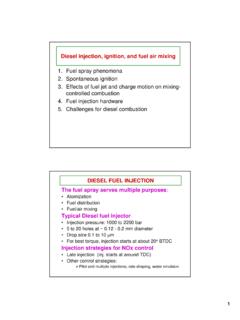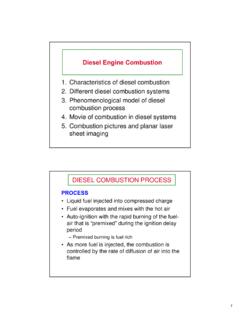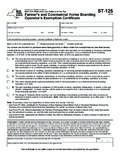Transcription of CHEMICAL GLOVE RESISTANCE GUIDE - MSC Industrial Direct
1 CHEMICAL GLOVE RESISTANCE GUIDEDEFINITION OF KEY TERMSP ermeation is a process by which a CHEMICAL can pass through a protective film without going through pinholes, pores, or other visible openings. Individual molecules of the CHEMICAL enter the film and squirm through by passing between the molecules of the GLOVE compound or film. In many cases the permeated material may appear unchanged to the human permeation can be described in simple terms by comparing it to what happens to the air in a balloon after several hours. Although there are no holes or defects, and the balloon is tightly sealed, the air gradually passes through (permeates) its walls and escapes. This simple example uses gas permeation, but the principle is the same with liquids or data is presented in two ways: Breakthrough time and Color code. Breakthrough times (min.) are the times observed from the start of the test to first detection of the CHEMICAL on the other side of the sample (see test chamber setup).
2 These times represent how long a GLOVE can be expected to provide effective permeation RESISTANCE when totally immersed in the test color code provides direction on the GLOVE s acceptance against the CHEMICAL . Green reflects the GLOVE will work well against the CHEMICAL versus red suggesting the GLOVE should not be recommended. The colors in between reflect protection acceptance based on the exposure time. Degradation is a reduction in one or more physical properties of a GLOVE material due to contact with a CHEMICAL . Certain GLOVE materials may become hard, stiff, or brittle, or they may grow softer, weaker, and swell to several times their original size. If a CHEMICAL has a significant impact on the physical properties of a GLOVE material, its permeation RESISTANCE is quickly note, however, that permeation and degradation do not always reviewing the following recommendations, remember that tests are conducted under laboratory conditions, and that actual workplace conditions usually dictate a combination of performance capabilities.
3 A product s RESISTANCE to cuts, punctures, and abrasion must also be taken into account as a critical usage factor. A GLOVE with excellent permeation RESISTANCE may not be adequate it if tears or punctures easily. Always factor in the physical performance requirements of the job or application when selecting a CHEMICAL -resistant s ASTM standard permeation and degradation are presented on the following pages as an aid in determining the general suitability of various products for use with specific chemicals. Because the conditions of ultimate use are beyond our control, and because we cannot run permeation tests in all possible work environments and across all combinations of chemicals and solutions, these recommendations are advisory only. THE SUITABILITY OF THE PRODUCT FOR A SPECIFIC JOB MUST BE DETERMINED BY TESTING BY THE acid, glacial100E>480'E120-240'E60-120'E>480'E >480'G30-60'G120-240'NR<10'F10-30'DD>480'sgl67-64-1 Acetone100E240-480'E>480'G<10'G<10'G<10'NR<10'NR<10'P60-120'NR<10'DD120-240'sgl75-05-8 Acetonitrile100E>480'E>480'E10-30'E10-30'E10-30'F<10'F10-30'E60-120'NR<10'DD>480' sgl79-10-7 Acrylic Acid100 >480' >480'E60-120'E>480'E>480'G30-60'G30-60'N R<10'NR30-60' >480'sglNRAcrylonitrile100E240-480'E>480' <10' 30-60' 30-60' <10' <10'E>480' <10'E240-480'sgl107-18-6 Allyl alcohol100E>480'E>480'E10-30'E240-480'E240-480'F30-6 0'F60-120'P<10'P60-120'E120-240' sgl1336-21-6 Ammonium Hydroxide25E>480'E10-30'E10-30'E>480'E>480'E120-240'E >480'NR<10'E10-30'E>480'sgl71-43-2 Benzene100P<10'E>480'NR<10'NR<10'NR<10'P<10'P30-60'E>480'NR<10'E240-480'sgl98-88-4 Benzoylchloride100 <10' >480' <10' <10' <10' <10' 10-30' >480' <10' sgl80-05-7 Bisphenol A100E>480'E>480'E>480'E>480'E>480'E>480'E>480' E240-480'E>480'E>480'sgl590-92-1 Bromopropionic acid100 >480' >480' >480' >480' >480'
4 >480' >480' <10' 120-240' >480'sgl111-76-22-Butoxyethanol100E>480'E >480'E30-60'E>480'E>480'E240-480'E240-48 0'E120-240'P<10'E>480'sgl123-86-4 Butyl acetate100E60-120'E>480'NR10-30'NR<10'NR<10'F10-30'F60-120'G>480'NR<10'DD<10'sgl71-36-3 Butyl alcohol100E>480'E>480'E120-240'E>480'E>480'E>480'E>4 80'F60-120'G120-240'E>480' sgl75-15-0 Carbon disulfide100P<10'E>480'NR<10'NR<10'NR<10'G10-30'G10-30'E>480'NR<10'E120-240'sgl56-23-5 Carbon Tetrachloride100F10-30' 240-480'NR<10'NR<10'NR<10'G240-480'G240-480'E>480'F10-30' 60-120'sgl67-66-3 Chloroform100P<10'E10-30'NR<10'NR<10'NR<10'NR<10'NR<10'E>480'NR<10'E120-240'sgl8007-45-2 Coal Tar100 <10' >480' 10-30' 60-120' 60-120' >480' >480' >480' 10-30' >480'sgl68308-34-9 Crude oil100P<10'E>480'P10-30'E60-120'E60-120'E>480'E>480'G >480'NR10-30'E>480'sgl108-93-0 Cyclohexanol100E>480'E>480'E10-30'E240-4 80'E240-480'E>480'E>480'G>480'E240-480'E >480'sgl108-94-1 Cyclohexanone100E>480'E>480'P30-60'P30-6 0'P60-120'F10-30'F30-60'E>480'NR30-60'P1 20-240'sgl84-74-2 Dibutyl Phtalate100 >480' >480'G10-30'F60-120'F60-120'G>480'G>480' E>480'NR60-120' sgl68334-30-5 diesel fuel100P<10'E>480'P30-60'E60-120'E60-120'E>480'E>480'G >480'NR30-60'E>480'sgl109-89-7 Diethylamine100F<10'E>480'NR<10'P<10'P<10'F10-30'F10-30'NR<10'NR10-30'NR10-30'sgl68-12-2 Dimethylformamide (DMFA)100E>480'E>480'E30-60'E30-60'E30-60'NR10-30'N R10-30'NR10-30'NR10-30'DD>480'sgl67-68-5 Dimethyl Sulfoxide (DMSO)100E>480'E>480'E>480'E>480'E>480'E 120-240'E240-480'NR<10'NR<10'DD>480'sgl64742-47-8 Distillate (petroleum)
5 , hydrotreated light100P<10'E>480'P10-30'E60-120'E60-120'E>480'E>480'G >480'NR10-30'E>480'sgl64-17-5 Ethanol100E240-480'E>480'E30-60'E240-480 'E240-480'E240-480'E>480'NR<10'G60-120'E>480'D = Degradation P = PermeationSee legend at the end for degradation and Permeation Breakthrough TimesMaterialButylLLDPEN atural Rubber/NeopreneNeopreneNeopreneNitrileNi trilePolyvinyl AlcoholPVCV iton ButylThickness (mil) Name / StyleChemTek Barrier Chemi-Pro Neoprene Scorpio Solvex AlphaTec PVA Snorkel ChemTek TypeCASC hemical name% 38-514 02-100 87-224 29-865 08-352 08-354 37-145 58-435 15-554 04-414 38-6122 DPDPDPDPDPDPDPDPDPDPsgl141-78-6 Ethyl acetate100E30-60'E>480'F<10'F10-30'F10-30'NR10-30'NR10-30'F>480'NR<10'DD10-30'sgl75-04-7 Ethylamine100 >480' >480' 10-30' 60-120' 60-120' 60-120' 60-120' 240-480' <10' sgl110-80-5 Ethyl Glycol100E>480'E>480'E10-30'E240-480'E240-480'G120- 240'G120-240'E60-120'P10-30'E60-120'sgl1 07-21-1 Ethylene Glycol100 >480'E>480'E>480'E>480'E>480'E>480'E>480 'F120-240'E>480' >480'sgl111-15-9 Ethylglycol acetate100E>480'E>480'E10-30'G30-60'G30- 60'F60-120'F60-120'E>480'NR10-30'DD sgl50-00-0 Formaldehyde35 240-480' >480' >480' >480' >480' >480' >480' <10' >480' >480'sgl64-18-6 Formic acid100E240-480'E>480'E60-120'E>480'E>48 0'F10-30'F30-60'NR<10' 120-240' 240-480' sgl76-13-1 Freon TF100 <10'
6 NR<10'E240-480'E240-480'E>480'E>480'G240-480'NR<10' sgl96-48-0 Gamma Butyrolactone100E>480'E>480'E240-480'E120-240'E120-240'NR<10'NR10-30'E120-240'NR<10'E>480'sgl8006-61-9 Gasoline100F10-30'E>480'NR<10'NR30-60'NR30-60'E120-240'E240-480'G>480'P60-120'E>480'sgl111-30-8 Glutaraldehyde, aquous solution50E>480'E>480'E>480'E>480'E>480' E>480'E>480'NR<10'E>480'E>480'sgl142-82-5 Heptane100P<10'E>480'P<10'E120-240'E120-240'E>480'E>480'E>480'NR<10'E>480'sgl999-97-3 Hexamethyldisilazane100E240-480'E>480'F6 0-120'E>480'E>480'E>480'E>480'G>480'P60- 120'E240-480'sgl110-54-3 Hexane100P<10'E>480'P<10'E30-60'E30-60'E>480'E>480'G>480'NR<10'E>480' sgl7647-01-0 Hydrochloric acid37 >480'E>480'E>480'E>480'E>480'E>480'E>480 'NR<10'E>480' >480' sgl7664-39-3 Hydrofluoric acid48E>480'E>480' >480'E>480'E>480'E30-60'E120-240'NR<10'E>480'E>480' sgl7722-84-1 Hydrogen Peroxide30E>480'E>480'G>480'E>480'E>480' E>480'E>480'NR<10'E>480'E>480'sgl540-84-1 Iso-octane100P30-60'E>480'P30-60'E>480'E >480'E>480'E>480'E>480'P30-60'E>480' sgl78-59-1 Isophorone100 >480' >480' 10-30' 60-120' 60-120' 120-240' 240-480' >480' <10' sgl67-63-0 Isopropanol100E>480'E>480'E120-240'E>480'E>480'E>480'E>4 80'NR60-120'G120-240'E>480'sgl64742-81-0
7 Kerosene100P<10'E>480'P10-30'E>480'E>480'E>480'E>480'G>480 'NR10-30'E>480'sgl110-16-7 Maleic acid, aquous solution50E>480'E>480'E>480'E>480'E>480' E>480'E>480'NR<10'G>480'E sgl67-56-1 Methanol100E>480'E>480'E30-60'E120-240'E 240-480'E30-60'E60-120'NR<10'G30-60'DD>480'sgl107-98-21-Methoxy-2-Propanol100 240-480' >480' 10-30' 60-120' 60-120' 120-240' 240-480' >480' 10-30' 240-480'sgl108-65-61-Methoxy-2-propylace tate100 >480' >480' <10' 10-30' 10-30' 120-240' 120-240' >480' <10' 10-30'sgl96-33-3 Methyl acrylate100 60-120' >480' <10' <10' <10' <10' 10-30' >480' <10' <10' sgl78-93-3 Methyl ethyl ketone100E60-120'E>480'P<10'P<10'P<10'NR<10'NR<10'F30-60'NR<10'DD10-30'sgl108-10-1 Methyl Isobutyl Ketone100 120-240' >480' <10' 10-30' 10-30' <10' 10-30' 60-120' <10' 10-30'Degradation and Permeation Breakthrough TimesMaterialButylLLDPEN atural Rubber/NeopreneNeopreneNeopreneNitrileNitrilePolyvinyl AlcoholPVCV iton ButylThickness (mil) Name / StyleChemTek Barrier Chemi-Pro Neoprene Scorpio Solvex AlphaTec PVA Snorkel ChemTek TypeCASC hemical name% 38-514 02-100 87-224 29-865 08-352 08-354 37-145 58-435 15-554 04-414 38-612D = Degradation P = PermeationSee legend at the end for degradation tert-Butyl Ether100G10-30'E>480'NR<10'P30-60'P30-60'E>480'E>480'G>480'NR<10' <10'sgl74-89-5 Methylamine, aquous solution40E>480'E>480'E10-30'E>480'E>480'E>480'E>480 'NR<10'E60-120'E sgl75-09-2 Methylenechloride100G<10'E10-30'NR<10'R<10'NR<10'NR<10'NR<10'G>480'NR<10'E30-60'sgl80-62-6 Methylmethacrylate100E30-60'E>480'NR<10'NR<10'NR<10'P10-30'P10-30'G240-480'NR<10'DD<10'sgl8012-95-1 Mineral Oil100P<10'E>480'P10-30'E60-120'E60-120'E>480'E>480'G >480'NR10-30'E>480'sgl108-90-7 Monochlorobenzene100P<10'E>480'NR<10'NR<10'NR<10'NR<10'NR10-30'E>480'NR<10'F>480'sgl141-43-5 Monoethanolamine100 >480' >480'E>480'E>480'E>480'E>480'E>480'E60-1 20'E>480'E240-480'sgl64742-82-1 Naptha (petroleum)
8 , hydrodesulfurized heavy100P<10'E>480'P10-30'E60-120'E60-120'E>480'E>480'G >480'NR10-30'E>480'sgl64742-49-0 Naphtha, petroleum, hydrotreated light100P<10'E>480'P10-30'E60-120'E60-120'E>480'E>480'G >480'NR10-30'E>480'sgl8030-30-6 Naphta VM&P100P<10'E>480'P10-30'E60-120'E60-120'E>480'E>480'G >480'NR10-30'E>480'sgl7697-37-2 Nitric acid70 >480'E>480'NR120-240'E>480'E>480'NR30-60 'NR30-60'NR<10'F30-60' sgl98-95-3 Nitrobenzene100E>480'E>480'F<10'NR<10'NR<10'NR60-120'NR60-120'G>480'NR<10'E>480'sgl872-50-4N-methyl-2-pyrrolidone100 E>480'E>480'F10-30'NR10-30'NR10-30'NR10- 30'NR10-30'NR<10'NR<10'DD60-120'sgl1120-21-4n-Undecane100P10-30'E>480'P30-60'E120-240'E120-240'E>480'E>480 'G>480'NR<10'E>480'sgl111-87-5 Octyl alcohol100E>480'E>480'E>480'E>480'E>480' E>480'E>480'G240-480'F240-480'E>480'sgl1 44-62-7 Oxalic acid, aquous solution99E>480'E>480'E>480'E>480'E>480' E>480'E>480'NR<10'E>480'E>480'sgl79-21-0 Peracetic acid39 >480' >480' 60-120' >480' >480' 120-240' 60-120' <10' 120-240' >480'sgl127-18-4 Perchloroethylene100P<10'E>480'NR10-30'NR<10'NR<10'G120-240'G240-480'E>480'NR<10'E>480'sgl108-95-2 Phenol100E>480'E>480'E120-240'E>480'E>48 0'NR60-120'NR60-120'F>480'G120-240'E>480 ' sgl7664-38-2 Phosphoric acid85 >480'E>480'G>480'G>480'G>480'E>480'E>480 'NR<10'G>480' >480'sgl110-85-0 Piperazine100E>480'E>480'E>480'E>480'E>4 80'E>480'E>480'E>480'E>480'E>480'sgl71-2 3-8 Propanol100E>480'E>480'E120-240'E>480'E> 480'E>480'E>480'P60-120'F120-240'E>480's gl107-12-0 Propionitrile100 >480' >480' <10' 60-120' 60-120' <10' 10-30' >480' <10' <10'sgl109-60-4 Propylacetate100E60-120'E>480'P<10'P<10'P<10'F10-30'F10-30'G>480'NR<10'DD<10'sgl57-55-6 Propylene Glycol100 >480' >480' >480' >480' >480' >480' >480' >480' >480' >480'sgl110-86-1
9 Pyridine100E60-120'E>480'P10-30'NR<10'NR<10'NR10-30'NR10-30'G<10'NR<10'DD30-60'sgl1310-73-2 Sodium Hydroxide50E>480'E>480'E>480'E>480'E>480'E>480'E>480' NR<10'G>480'E>480'Degradation and Permeation Breakthrough TimesMaterialButylLLDPEN atural Rubber/NeopreneNeopreneNeopreneNitrileNi trilePolyvinyl AlcoholPVCV iton ButylThickness (mil) Name / StyleChemTek Barrier Chemi-Pro Neoprene Scorpio Solvex AlphaTec PVA Snorkel ChemTek TypeCASC hemical name% 38-514 02-100 87-224 29-865 08-352 08-354 37-145 58-435 15-554 04-414 38-612D = Degradation P = PermeationSee legend at the end for degradation Solvent100P<10'E>480'G10-30'E60-120'E60-120'E>480'E>480'G >480'F10-30'E>480'sgl100-42-5 Styrene100P10-30'E>480'NR<10'NR<10'NR<10'NR10-30'NR10-30'G>480'NR10-30'E>480' sgl7664-93-9 Sulphuric acid96E240-480'E>480'NR120-240'F240-480' F240-480'NR30-60'NR120-240'NR<10'G30-60'E>480'sgl109-99-9 Tetrahydrofuran100F<10'E>480'NR<10'NR<10'NR<10'NR<10'NR10-30'P30-60'NR<10'DD<10'sgl110-01-0 Tetrahydrothiophene100 >480' >480' 10-30' <10' <10' 10-30' 30-60' >480' 10-30' sgl7719-09-7 Thionylchloride100 60-120' 120-240' <10' <10' <10' <10' <10' 120-240' <10' sgl108-88-3 Toluene100P<10'E>480'NR<10'NR<10'NR<10'F10-30'F10-30'G>480'NR<10'E>480' sgl79-01-6
10 Trichloroethylene100NR<10'E>480'NR<10'NR<10'NR<10'NR10-30'NR10-30'E>480'NR<10'DD120-240'sgl1330-78-5 Tricresyl Phosphate100E>480' >480'E>480'F>480'F>480'E>480'E<480'G>480'F>480'E>480'sgl102-71-6 Triethanolamine100 >480' >480' 240-480'E>480'E>480'E240-480'E>480'G240- 480'E>480' 240-480'sgl121-44-8 Triethylamine100 <10' >480' <10' <10' <10' >480' >480' >480' <10' 240-480'sgl64742-88-7 White Spirit100P<10'E>480'P10-30'E60-120'E60-120'E>480'E>480'G >480'NR10-30'E>480'sgl1330-20-7 Xylene100P10-30'E>480'NR<10'NR10-30'NR10-30'F10-30'G30-60'E>480'NR<10'E>480'Permeation Breakthrough Times (min)<10 Not Recommended10-30 Splash Protection30-60 Splash Protection60-120 Medium Protection120-240 Medium Protection240-480 Good Protection>480 Good ProtectionDegradation RatingsDDDelamination of Outer LayerNRNot DisclaimerRecommendations are based on extrapolations from laboratory test results and information regarding the composition of chemicals and may not adequately represent specific conditions of end use.





